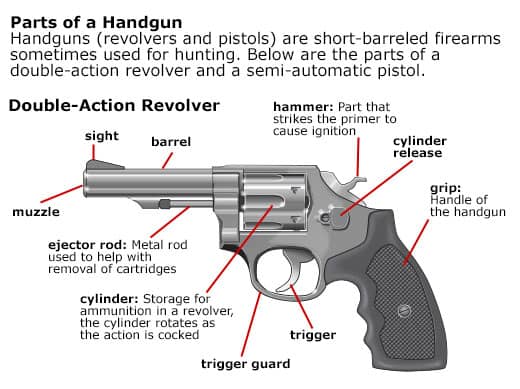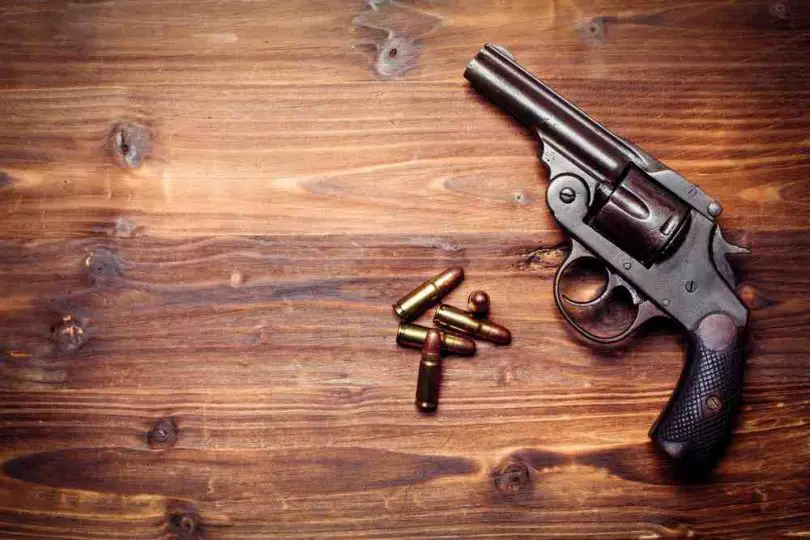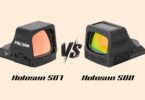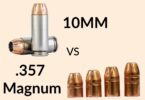Although the term “revolver” and “pistol” are used interchangeably, they don’t refer to the same firearm. A revolver AKA a “wheel gun” is a special type of handgun that features a revolving cylinder containing multiple chambers, each of which can hold a single cartridge.
When the trigger of a revolver is pulled, the mechanism inside rotates the cylinder and brings the next chamber into position, aligning it with the barrel and the gun is ready to fire again. They can be single or double action, and come in various calibers and sizes.
If you own a revolver, I’m sure you’ve wondered about how a revolver works at some point, right? Well, we’re here to help. This guide will provide a general overview on how a revolver works, what are the parts of a revolver, and what are the advantages/disadvantages of having one.
Without any further ado, let’s jump right in!
How a Revolver Works: Let’s Learn Your Gun
Anatomy of a Revolver

The Frame
This is listed as the major part of a revolver because all other parts share an attachment with it in one way or the other.
The Grip Panels
This part is important for holding and gripping your gun.
Attached to the lower frame portion, the grip is most times made from wood, molded plastic, animal bone, or rubber, which are fixed using different sizes of screws.
The Trigger Guard
This is located directly underneath the frame, and it is designed to guard the trigger against discharging a bullet unintentionally.
The Barrel
This is a metal tube that serves as a passage for bullets. The ridges that exist between the groves are known as “lands.” The combination of the groves and the lands explains the term “rifling.”
Rifling makes the projectile or the bullet move with more stability. The front part of the Barrel is known as the muzzle.
The Action
This explains a group of external and internal parts attached to the revolver frame, which helps it to function correctly.
The Trigger
This is located underneath the frame very close to the hammer.
Once the trigger is pulled, the mechanism releases the hammer and strikes directly on the firing pin, which in turn strikes the cartridge, and the gun fires.
Actions are grouped into two: double and single – the double action occurs once you pull the trigger. The hammer is forced back, and the firing pin is forced to hit the cartridge.
On the other hand, a single action happens once you pull the trigger; this time, the hammer is forced to strike the gun firing pin.
This demands you pull back the hammer on each shot, similar to what you get when using an old cowboy revolver seen in the movies.
The Cylinder
This is a cylindrical metal with holes of the same size; it is also known as the chamber that holds each cartridge in a regular pattern. There are 5-8 chambers in the cylinder, each of which houses a single bullet.
Every cock on the hammer will force the cylinder to rotate to the next cartridge.
The cylinder has a latch which is located at the side of the frame; this helps it to move in and out for unloading and reloading purposes.
The Ejector Rod
This is yet another feature component found in modern revolvers. It helps to remove spent cartridges away from the cylinder.
Revolver Work Principle: By Types of Actions
Single-Action Revolver (SA)
So, how does a single action revolver work? Here’s how:
Single-action revolvers are manually cocked; this is usually done with the thumb you use to support the gun.
Once the gun is cocked, the cylinder is forced to rotate and move to the next round while it remains locked in the direction of the chamber.
Immediately the trigger is pulled, and the hammer is released to fire rounds.
And if you intend to fire again, you will have to cock the hammer manually. This process is known as a single action because the action triggers only one performance.
Double-Action Revolver (DA)
The double-action revolver allows you to generate two actions.
When the hammer is pulled or cocked, the cylinder is forced to rotate and get to the next round, followed by the next step when the hammer is released to strike the firing pin.
When you pull the trigger, it hardly becomes a trade-off for double action.
Although it has some other forms of drawbacks, this is considered a safety feature against the accidental discharge of bullets, which happens the most when the gun drops accidentally.
You can fire double-action revolvers either way; i.e., either as a double or single-action.
Double-Action-Only (DAO)
The revolver doesn’t come with a latch; this means the hammer cannot be locked to the rear part of the gun.
The double-action-only is created to have a spurless or bobbed hammer, and most times, the hammer is completely covered within the revolver’s frame.
Since the gun hammer cannot be locked back, you can only use them to fire twice. Here’s a video guide on how a revolver works.
Advantages and Disadvantages of Revolvers
Advantages of Revolvers
Now that we’re done with how a revolver works, let’s explore the advantages and disadvantages a revolver brings about. There are several advantages to owning a revolver:
Reliability
Revolvers are known for their reliability and simplicity. They are less likely to jam or malfunction as revolvers have fewer moving parts than semi-automatic pistols.
Ease of use
Revolvers are easy to use and require less training than semi-automatic pistols. They typically have simpler controls and are easier to load/unload.
Versatility
Revolvers can fire a variety of different types of ammunition, making them versatile for different applications, such as self-defense, target shooting, or hunting.
Accuracy
Revolvers are often more accurate than semi-automatic pistols due to their fixed barrels and longer sight radius.
Durability
Revolvers are built to withstand heavy use and can often last for decades or even generations with proper maintenance.
Safety
Revolvers do not have external safeties, which can make them faster to draw and fire in self-defense situations.
Disadvantages of Revolvers
While there are several advantages to owning a revolver, there are also some potential disadvantages to consider:
Capacity
Revolvers typically have a lower ammunition capacity than semi-automatic pistols. Most revolvers only hold 5-8 rounds, while many modern pistols can hold 10 rounds or even more. This can be a disadvantage in situations where multiple rounds may be needed.
Slow Reloading
Reloading a revolver can be slower and more cumbersome than reloading a semi-automatic pistol. The shooter must manually eject spent casings and insert new rounds into the cylinder, which can take time and require some dexterity.
Size and Weight
Revolvers tend to be bulkier and heavier than semi-automatic pistols, especially those with larger cylinders. This can make them more difficult to carry for extended periods or to conceal.
Recoil
Revolvers typically have more felt recoil than semi-automatic pistols due to their design. This can make them more difficult to shoot accurately, especially for inexperienced shooters or those with weaker hand strength.
Cost
High-quality revolvers can be expensive, especially compared to some entry-level semi-automatic pistols.
Limited customization options
Revolvers are typically less customizable than semi-automatic pistols, which can make it harder to tailor them to specific needs or preferences.
Conclusion
The double-action and the double-action-only are the main recommended revolvers to go for in terms of self-defense. The single action fires one round only, and this can take time and appears a bit difficult when you intend to shoot more than one round.
And with that, we’ve reached the end of our today’s discussion. Today, we’ve provided a general overview of the working principle of a revolver. We’ve also answered questions like how does a revolver work (single action), how does a double action revolver work, and what are the pros/cons of having one.
I hope this information proves to be helpful. Thank you for reading this far. Please feel free to contact us if you have any thoughts or opinions to share.
No matter which type of firearm you’re using, never forget to maintain the gun safety rules and take good care of your revolver. I wish you all a great weekend ahead, and happy shooting to you!
FAQ
1. How Does A Revolver Cylinder Rotate?
Ans. Most revolvers use a pawl and ratchet system or a hand and star system to rotate the cylinder. Both of those systems rely on the hammer to push the pawl or a cam while returning to its position after you fire the gun. The design largely depends on the manufacturer.
How Does A Revolver Hammer Work?
Ans. The hammer of a revolver is usually supported by a spring mechanism. When you pull the trigger, the hammer gets released from its cocked position and hits the firing pin. The pin then hits the primer, causing the primer to ignite and fire the bullet.
3. What Are The Different Types Of Revolvers?
Ans. The 4 most popular types of revolvers are:
- Single Action Revolver
- Double Action Revolver
- Top Break Revolvers
- Swing Out Cylinder Revolvers
4. Why Is A Revolver Best For Self-Defense?
Ans. Because revolvers are extremely reliable and simple to use. Even if you fail to maintain your revolver for a long time, you can expect it to work without any issue when you need it the most. However, not taking care of your firearms is not advisable by any means.
5. Why Don’t Revolvers Have Safety?
Ans. Revolvers usually rely on you to manually cock the hammer before shooting. Also, some revolvers use long and heavy trigger pulls to avoid unnecessary firing. These mechanisms work seamlessly to make sure there are no “accidental shots”.









Leave a Comment